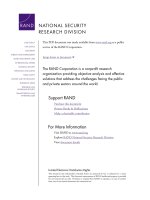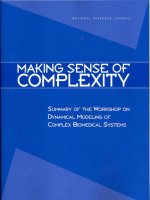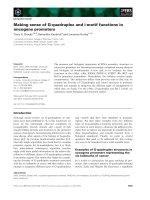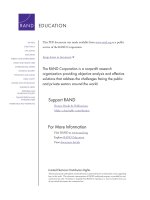Making sense of NoSQL
Bạn đang xem bản rút gọn của tài liệu. Xem và tải ngay bản đầy đủ của tài liệu tại đây (26.01 MB, 314 trang )
www.it-ebooks.info
Making Sense of NoSQL
www.it-ebooks.info
www.it-ebooks.info
Making Sense of NoSQL
A GUIDE FOR MANAGERS
AND THE REST OF US
DAN MCCREARY
ANN KELLY
MANNING
SHELTER ISLAND
www.it-ebooks.info
For online information and ordering of this and other Manning books, please visit
www.manning.com. The publisher offers discounts on this book when ordered in quantity.
For more information, please contact
Special Sales Department
Manning Publications Co.
20 Baldwin Road
PO Box 261
Shelter Island, NY 11964
Email:
©2014 by Manning Publications Co. All rights reserved.
No part of this publication may be reproduced, stored in a retrieval system, or transmitted, in
any form or by means electronic, mechanical, photocopying, or otherwise, without prior written
permission of the publisher.
Many of the designations used by manufacturers and sellers to distinguish their products are
claimed as trademarks. Where those designations appear in the book, and Manning
Publications was aware of a trademark claim, the designations have been printed in initial caps
or all caps.
Recognizing the importance of preserving what has been written, it is Manning’s policy to have
the books we publish printed on acid-free paper, and we exert our best efforts to that end.
Recognizing also our responsibility to conserve the resources of our planet, Manning books
are printed on paper that is at least 15 percent recycled and processed without the use of
elemental chlorine.
Manning Publications Co.
20 Baldwin Road
PO Box 261
Shelter Island, NY 11964
Development editor:
Copyeditor:
Proofreader:
Typesetter:
Cover designer:
ISBN 9781617291074
Printed in the United States of America
1 2 3 4 5 6 7 8 9 10 – MAL – 18 17 16 15 14 13
www.it-ebooks.info
Elizabeth Lexleigh
Benjamin Berg
Katie Tennant
Dottie Marsico
Leslie Haimes
To technology innovators and early adopters…
those who shake up the status quo
We dedicate this book to people who understand the limitations of our current way of
solving technology problems. They understand that by removing limitations, we can
solve problems faster and at a lower cost and, at the same time, become more agile.
Without these people, the NoSQL movement wouldn’t have gained the critical mass it
needed to get off the ground.
Innovators and early adopters are the people within organizations who shake up the
status quo by testing and evaluating new architectures. They initiate pilot projects and
share their successes and failures with their peers. They use early versions of software
and help shake out the bugs. They build new versions of NoSQL distributions from
source and explore areas where new NoSQL solutions can be applied. They’re the
people who give solution architects more options for solving business problems. We
hope this book will help you to make the right choices.
www.it-ebooks.info
www.it-ebooks.info
brief contents
PART 1 INTRODUCTION ............................................................1
1
■
NoSQL: It’s about making intelligent choices
2
■
NoSQL concepts 15
3
PART 2 DATABASE PATTERNS .................................................. 35
3
■
Foundational data architecture patterns
4
■
NoSQL data architecture patterns
5
■
Native XML databases
37
62
96
PART 3 NOSQL SOLUTIONS . .................................................125
6
■
Using NoSQL to manage big data
127
7
■
Finding information with NoSQL search
8
■
Building high-availability solutions with NoSQL
9
■
Increasing agility with NoSQL
154
172
192
PART 4 ADVANCED TOPICS . ...................................................207
10
■
NoSQL and functional programming
11
■
Security: protecting data in your NoSQL systems 232
12
■
Selecting the right NoSQL solution
vii
www.it-ebooks.info
209
254
www.it-ebooks.info
contents
foreword xvii
preface xix
acknowledgments xxi
about this book xxii
PART 1
1
INTRODUCTION .................................................1
NoSQL: It’s about making intelligent choices 3
1.1
1.2
What is NoSQL? 4
NoSQL business drivers 6
Volume
1.3
7
■
Velocity
NoSQL case studies
7
■
Variability
7
■
Agility
8
8
Case study: LiveJournal’s Memcache 9 Case study: Google’s
MapReduce—use commodity hardware to create search indexes 10
Case study: Google’s Bigtable—a table with a billion rows and a million
columns 11 Case study: Amazon’s Dynamo—accept an order 24
hours a day, 7 days a week 11 Case study: MarkLogic 12
Applying your knowledge 12
■
■
■
1.4
Summary
13
ix
www.it-ebooks.info
x
CONTENTS
2
NoSQL concepts 15
2.1
2.2
2.3
2.4
2.5
Keeping components simple to promote reuse 15
Using application tiers to simplify design 17
Speeding performance by strategic use of RAM, SSD,
and disk 21
Using consistent hashing to keep your cache current 22
Comparing ACID and BASE—two methods of reliable
database transactions 24
RDBMS transaction control using ACID
transaction control using BASE 27
2.6
2.7
2.8
2.9
2.10
PART 2
3
25
■
Non-RDBMS
Achieving horizontal scalability with database
sharding 28
Understanding trade-offs with Brewer’s CAP theorem
Apply your knowledge 32
Summary 33
Further reading 33
30
DATABASE PATTERNS ...................................... 35
Foundational data architecture patterns
37
3.1 What is a data architecture pattern? 38 3.2
Understanding the row-store design pattern used in
RDBMSs 39
How row stores work 39 Row stores evolve 41
Analyzing the strengths and weaknesses of the row-store pattern
■
3.3
3.4
42
Example: Using joins in a sales order 43
Reviewing RDBMS implementation features 45
RDBMS transactions 45 Fixed data definition language and
typed columns 47 Using RDBMS views for security and access
control 48 RDBMS replication and synchronization 49
■
■
■
3.5
Analyzing historical data with OLAP, data warehouse, and
business intelligence systems 51
How data flows from operational systems to analytical systems 52
Getting familiar with OLAP concepts 54 Ad hoc reporting using
aggregates 55
■
www.it-ebooks.info
xi
CONTENTS
3.6
3.7
3.8
3.9
3.10
4
Incorporating high availability and read-mostly
systems 57
Using hash trees in revision control systems and database
synchronization 58
Apply your knowledge 60
Summary 60
Further reading 61
NoSQL data architecture patterns 62
4.1
Key-value stores
63
What is a key-value store? 64 Benefits of using a key-value
store 65 Using a key-value store 68 Use case: storing web
pages in a key-value store 70 Use case: Amazon simple storage
service (S3) 71
■
■
■
■
4.2
Graph stores
72
Overview of a graph store 72 Linking external data with the
RDF standard 74 Use cases for graph stores 75
■
■
4.3
Column family (Bigtable) stores
81
Column family basics 82 Understanding column family
keys 82 Benefits of column family systems 83
Case study: storing analytical information in Bigtable 85
Case study: Google Maps stores geographic information in
Bigtable 85 Case study: using a column family to store user
preferences 86
■
■
■
4.4
Document stores 86
Document store basics 87 Document collections 88
Application collections 88 Document store APIs 89
Document store implementations 89 Case study: ad server with
MongoDB 90 Case study: CouchDB, a large-scale object
database 91
■
■
■
■
4.5
Variations of NoSQL architectural patterns
Customization for RAM or SSD stores 92
Grouping items 93
4.6
4.7
Summary 95
Further reading 95
www.it-ebooks.info
■
91
Distributed stores
92
xii
CONTENTS
5
Native XML databases
5.1
5.2
96
What is a native XML database? 97
Building applications with a native XML database
100
Loading data can be as simple as drag-and-drop 101 Using
collections to group your XML documents 102 Applying simple
queries to transform complex data with XPath 105
Transforming your data with XQuery 106 Updating
documents with XQuery updates 109 XQuery full-text
search standards 110
■
■
■
■
5.3
5.4
Using XML standards within native XML databases 110
Designing and validating your data with XML Schema
and Schematron 112
XML Schema
rules 113
5.5
5.6
5.7
112
Using Schematron to check document
■
Extending XQuery with custom modules 115
Case study: using NoSQL at the Office of the Historian
at the Department of State 115
Case study: managing financial derivatives with
MarkLogic 119
Why financial derivatives are difficult to store in RDBMSs 119
An investment bank switches from 20 RDBMSs to one native XML
system 119 Business benefits of moving to a native XML
document store 121 Project results 122
■
■
5.8
5.9
PART 3
6.1
6
Summary 122
Further reading 123
NOSQL SOLUTIONS . .....................................125
Using NoSQL to manage big data
127
What is a big data NoSQL solution? 128 6.2
Getting linear scaling in your data center 132 6.3
Understanding linear scalability and expressivity 133 6.4
Understanding the types of big data problems 135 6.5
Analyzing big data with a shared-nothing
architecture 136 6.6 Choosing distribution models: master-slave versus
peer-to-peer 137
www.it-ebooks.info
xiii
CONTENTS
6.7
Using MapReduce to transform your data over distributed
systems 139
MapReduce and distributed filesystems 140 How MapReduce
allows efficient transformation of big data problems 142
■
6.8
Four ways that NoSQL systems handle big data
problems 143
Moving queries to the data, not data to the queries 143 Using
hash rings to evenly distribute data on a cluster 144 Using
replication to scale reads 145 Letting the database distribute
queries evenly to data nodes 146
■
■
■
6.9
Case study: event log processing with Apache Flume
146
Challenges of event log data analysis 147 How Apache Flume
works to gather distributed event data 148 Further
thoughts 149
■
■
6.10
Case study: computer-aided discovery of health care
fraud 150
What is health care fraud detection? 150 Using graphs and
custom shared-memory hardware to detect health care fraud 151
■
6.11
6.12
7
Summary 152
Further reading 153
Finding information with NoSQL search 154
7.1
7.2
What is NoSQL search? 155
Types of search 155
Comparing Boolean, full-text keyword, and structured search
models 155 Examining the most common types of search 156
■
7.3
7.4
7.5
7.6
7.7
7.8
Strategies and methods that make NoSQL search
effective 158
Using document structure to improve search quality 161
Measuring search quality 162
In-node indexes versus remote search services 163
Case study: using MapReduce to create reverse
indexes 164
Case study: searching technical documentation 166
What is technical document search? 166 Retaining document
structure in a NoSQL document store 167
■
www.it-ebooks.info
xiv
CONTENTS
7.9
7.10
7.11
7.12
8
Case study: searching domain-specific languages—
findability and reuse 168
Apply your knowledge 170
Summary 170
Further reading 171
Building high-availability solutions with NoSQL 172
8.1
8.2
What is a high-availability NoSQL database? 173
Measuring availability of NoSQL databases 174
Case study: the Amazon’s S3 SLA 176 Predicting system
availability 176 Apply your knowledge 177
■
■
8.3
NoSQL strategies for high availability
178
Using a load balancer to direct traffic to the least busy
node 178 Using high-availability distributed filesystems
with NoSQL databases 179 Case study: using HDFS as
a high-availability filesystem to store master data 180
Using a managed NoSQL service 182Case study: using
Amazon DynamoDB for a high-availability data store 182
■
■
8.4
Case study: using Apache Cassandra as a high-availability
column family store 184
Configuring data to node mappings with Cassandra 185
8.5
8.6
8.7
9
Case study: using Couchbase as a high-availability
document store 187
Summary 189
Further reading 190
Increasing agility with NoSQL 192
9.1
What is software agility? 193
Apply your knowledge: local or cloud-based deployment? 195
9.2
9.3
9.4
Measuring agility 196
Using document stores to avoid object-relational
mapping 199
Case study: using XRX to manage complex forms
201
What are complex business forms? 201 Using XRX to
replace client JavaScript and object-relational mapping 202
Understanding the impact of XRX on agility 205
■
www.it-ebooks.info
xv
CONTENTS
9.5
9.6
PART 4
10.1
Summary 205
Further reading 206
ADVANCED TOPICS . ........................................207
NoSQL and functional programming
10
What is functional programming? 210
209
Imperative programming is managing program
state 211 Functional programming is parallel transformation
without side effects 213 Comparing imperative and functional
programming at scale 216 Using referential transparency to
avoid recalculating transforms 217
■
■
■
10.2
Case study: using NetKernel to optimize web page content
assembly 219
Assembling nested content and tracking component
dependencies 219 Using NetKernel to optimize component
regeneration 220
■
10.3
10.4
Examples of functional programming languages 222
Making the transition from imperative to functional
programming 223
Using functions as a parameter of a function 223 Using
recursion to process unstructured document data 224 Moving
from mutable to immutable variables 224 Removing loops and
conditionals 224 The new cognitive style: from capturing state to
isolated transforms 225 Quality, validation, and consistent unit
testing 225 Concurrency in functional programming 226
■
■
■
■
■
■
10.5
10.6
10.7
10.8
11
Case study: building NoSQL systems with Erlang 226
Apply your knowledge 229
Summary 230
Further reading 231
Security: protecting data in your NoSQL systems 232
11.1
A security model for NoSQL databases
233
Using services to mitigate the need for in-database security 235
Using data warehouses and OLAP to mitigate the need for
in-database security 235 Summary of application versus
database-layer security benefits 236
■
www.it-ebooks.info
xvi
CONTENTS
11.2
Gathering your security requirements
237
Authentication 237 Authorization 240 Audit and
logging 242 Encryption and digital signatures 243
Protecting pubic websites from denial of service and injection
attacks 245
■
■
■
11.3
Case Study: access controls on key-value store—
Amazon S3 246
Identity and Access Management (IAM)
(ACL) 247 Bucket policies 248
247
Access-control lists
■
■
11.4
11.5
Case study: using key visibility with Apache
Accumulo 249
Case study: using MarkLogic’s RBAC model in secure
publishing 250
Using the MarkLogic RBAC security model to protect
documents 250 Using MarkLogic in secure publishing 251
Benefits of the MarkLogic security model 252
■
11.6
11.7
12
Summary 252
Further reading 253
Selecting the right NoSQL solution
12.1
12.2
254
What is architecture trade-off analysis? 255
Team dynamics of database architecture selection
257
Selecting the right team 258 Accounting for experience
bias 259 Using outside consultants 259
■
■
12.3
12.4
Steps in architectural trade-off analysis 260
Analysis through decomposition: quality trees
Sample quality attributes
architectures 266
12.5
264
■
263
Evaluating hybrid and cloud
Communicating the results to stakeholders
267
Using quality trees as navigational maps 267 Apply your
knowledge 269 Using quality trees to communicate project
risks 270
■
■
12.6
12.7
12.8
Finding the right proof-of-architecture pilot project 271
Summary 273
Further reading 274
index
275
www.it-ebooks.info
foreword
Where does one start to explain a topic that’s defined by what it isn’t, rather than what
it is? Believe me, as someone who’s been trying to educate people in this field for the
past three years, it’s a frustrating dilemma, and one shared by lots of technical experts,
consultants, and vendors. Even though few think the name NoSQL is optimal, almost
everyone seems to agree that it defines a category of products and technologies better
than any other term. My best advice is to let go of whatever hang-ups you might have
about the semantics, and just choose to learn about something new. And trust me
please…the stuff you’re about to learn is worth your time.
Some brief personal context up front: as a publisher in the world of information
management, I had heard the term NoSQL, but had little idea of its significance until
three years ago, when I ran into Dan McCreary in the corridor of a conference in
Toronto. He told me a bit about his current project and was obviously excited about
the people and technologies he was working with. He convinced me in no time that
this NoSQL thing was going to be huge, and that someone in my position should
learn as much as I could about it. It was excellent advice, and we’ve had a wonderful
partnership since then, running a conference together, doing webinars, and writing
white papers. Dan was spot on…this NoSQL stuff is exciting, and the people in the
community are quite brilliant.
Like most people who work in arcane fields, I often find myself trying to explain
complex things in simple terms for the benefit of those who don’t share the same passion or context that I have. And even when you understand the value of the perfect
elevator pitch, or desperately want to explain what you do to your mother, the right
explanation can be elusive. Sometimes it’s even more difficult to explain new things to
xvii
www.it-ebooks.info
xviii
FOREWORD
people who have more knowledge, rather than less. Specifically in terms of NoSQL,
that’s the huge community of relational DBMS devotees who’ve existed happily and
efficiently for the past 30 years, needing nothing but one toolkit.
That’s where Making Sense of NoSQL comes in. If you’re in an enterprise computing
role and trying to understand the value of NoSQL, then you’re going to appreciate
this book, because it speaks directly to you. Sure, you startup guys will get something
out of it, but for enterprise IT folks, the barriers are pretty daunting—not the least of
which will be the many years of technical bias accumulated against you from the people in your immediate vicinity, wondering why the heck you’d want to put your data
into anything but a nice, orderly table.
The authors understand this, and have focused a lot of their analysis on the technical and architectural trade-offs that you’ll be facing. I also love that they’ve undertaken so much effort to offer case studies throughout the book. Stories are key to
persuasion, and these examples drawn from real applications provide a storyline to
the subject that will be invaluable as you try to introduce these new technologies into
your organization.
Dan McCreary and Ann Kelly have provided the first comprehensive explanation
of what NoSQL technologies are, and why you might want to use them in a corporate
context. While this is not meant to be a technical book, I can tell you that behind the
scenes they’ve been diligent about consulting with the product architects and developers to ensure that the nuances and features of different products are represented
accurately.
Making Sense of NoSQL is a handbook of easily digestible, practical advice for technical managers, architects, and developers. It’s a guide for anyone who needs to understand the full range of their data management options in the increasingly complex
and demanding world of big, fast data. The title of chapter 1 is “NoSQL: It’s about
making intelligent choices,” and based on your selection of this book, I can confirm
that you’ve made one already.
TONY SHAW
FOUNDER AND CEO
DATAVERSITY
www.it-ebooks.info
preface
Sometimes we’re presented with facts that force us to reassess what we think we know.
After spending most of our working life performing data modeling tasks with a focus
on storing data in rows, we learned that the modeling process might not be necessary.
While this information didn’t mean our current knowledge was invalid, it forced us to
take a hard look at how we solved business technology problems. Armed with new
knowledge, techniques, and problem-solving styles, we broadened the repertoire of
our solution space.
In 2006, while working on a project that involved the exchange of real estate transactions, we spent many months designing XML schemas and forms to store the complex hierarchies of data. On the advice of a friend (Kurt Cagle), we found that storing
the data into a native XML database saved our project months of object modeling,
relational database design, and object-relational mapping. The result was a radically
simple architecture that could be maintained by nonprogammers.
The realization that enterprise data can be stored in structures other than RDBMSs
is a major turning point for people who enter the NoSQL space. Initially, this information may be viewed with skepticism, fear, and even self-doubt. We may question our
own skills as well as the educational institutions that trained us and the organizations
that reinforce the notion that RDBMS and objects are the only way to solve problems.
Yet if we’re going to be fair to our clients, customers, and users, we must take a holistic
approach to find the best fit for each business problem and evaluate other database
architectures.
In 2010, frustrated with the lack of exposure NoSQL databases were getting at
large enterprise data conferences, we approached Tony Shaw from DATAVERSITY
xix
www.it-ebooks.info
xx
PREFACE
about starting a new conference. The conference would be a venue for anyone interested in learning about NoSQL technologies and exposing individuals and organizations to the NoSQL databases available to them. The first NoSQL Now! conference
was successfully held in San Jose, California, in August of 2011, with approximately
500 interested and curious attendees.
One finding of the conference was that there was no single source of material that
covered NoSQL architectures or introduced a process to objectively match a business
problem with the right database. People wanted more than a collection of “Hello
World!” examples from open source projects. They were looking for a guide that
helped them match a business problem to an architecture first, and then a process
that allowed them to consider open source as well as commercial database systems.
Finding a publisher that would use our existing DocBook content was the first step.
Luckily, we found that Manning Publications understands the value of standards.
www.it-ebooks.info
acknowledgments
We’d like to thank everyone at Manning Publications who helped us take our raw
ideas and transform them into a book: Michael Stephens, who brought us on board;
Elizabeth Lexleigh, our development editor, who patiently read version after version
of each chapter; Nick Chase, who made all the technology work like it’s supposed to;
the marketing and production teams, and everyone who worked behind the scenes—
we acknowledge your efforts, guidance, and words of encouragement.
To the many people who reviewed case studies and provided us with examples of
real-world NoSQL usage—we appreciate your time and expertise: George Bina, Ben
Brumfield, Dipti Borkar, Kurt Cagle, Richard Carlsson, Amy Friedman, Randolph
Kahle, Shannon Kempe, Amir Halfon, John Hudzina, Martin Logan, Michaline Todd,
Eric Merritt, Pete Palmer, Amar Shan, Christine Schwartz, Tony Shaw, Joe Wicentowski, Melinda Wilken, and Frank Weige.
To the reviewers who contributed valuable insights and feedback during the development of our manuscript—our book is better for your input: Aldrich Wright, Brandon Wilhite, Craig Smith, Gabriela Jack, Ian Stirk, Ignacio Lopez Vellon, Jason Kolter,
Jeff Lehn, John Guthrie, Kamesh Sampah, Michael Piscatello, Mikkel Eide Eriksen,
Philipp K. Janert, Ray Lugo, Jr., Rodrigo Abreu, and Roland Civet.
We’d like to say a special thanks to our friend Alex Bleasdale for providing us with
working code to support the role-based, access-control case study in our chapter on
NoSQL security and secure document publishing. Special thanks also to Tony Shaw
for contributing the foreword, and to Leo Polovets for his technical proofread of the
final manuscript shortly before it went to production.
xxi
www.it-ebooks.info
about this book
In writing this book, we had two goals: first, to describe NoSQL databases, and second,
to show how NoSQL systems can be used as standalone solutions or to augment current SQL systems to solve business problems. We invite anyone who has an interest in
learning about NoSQL to use this book as a guide. You’ll find that the information,
examples, and case studies are targeted toward technical managers, solution architects, and data architects who have an interest in learning about NoSQL.
This material will help you objectively evaluate SQL and NoSQL database systems
to see which business problems they solve. If you’re looking for a programming guide
for a particular product, you’ve come to wrong place. In this book you’ll find information about the motivations behind NoSQL, as well as related terminology and concepts. There might be sections and chapters of this book that cover topics you already
understand; feel free to skim or skip over them and focus on the unknown.
Finally, we feel strongly about and focus on standards. The standards associated
with SQL systems allow applications to be ported between databases using a common
language. Unfortunately, NoSQL systems can’t yet make this claim. In time, NoSQL
application vendors will pressure NoSQL database vendors to adopt a set of standards
to make them as portable as SQL.
Roadmap
This book is divided into four parts. Part 1 sets the stage by defining NoSQL and
reviewing the basic concepts behind the NoSQL movement.
In chapter 1, “NoSQL: It’s about making intelligent choices,” we define the term
NoSQL, talk about the key events that triggered the NoSQL movement, and present a
xxii
www.it-ebooks.info
ABOUT THIS BOOK
xxiii
high-level view of the business benefits of NoSQL systems. Readers already familiar with
the NoSQL movement and the business benefits might choose to skim this chapter.
In chapter 2, “NoSQL concepts,” we introduce the core concepts associated with
the NoSQL movement. Although you can skim this chapter on a first read-through, it’s
important for understanding material in later chapters. We encourage you to use this
chapter as a reference guide as you encounter these concepts throughout the book.
In part 2, “Database patterns,” we do an in-depth review of SQL and NoSQL database
architecture patterns. We look at the different database structures and how we access
them, and present use cases to show the types of situations where each architectural
pattern is best used.
Chapter 3 covers “Foundational data architecture patterns.” It begins with a review
of the drivers behind RDBMSs and how the requirements of ERP systems shaped the
features we have in current RDBMS and BI/DW systems. We briefly discuss other database systems such as object databases and revision control systems. You can skim this
chapter if you’re already familiar with these systems.
In chapter 4, “NoSQL data architecture patterns,” we introduce the database patterns associated with NoSQL. We look at key-value stores, graph stores, column family
(Bigtable) systems, and document databases. The chapter provides definitions, examples, and case studies to facilitate understanding.
Chapter 5 covers “Native XML databases,” which are most often found in government and publishing applications, as they are known to lower costs and support the
use of standards. We present two case studies from the financial and government publishing areas.
In part 3, we look at how NoSQL systems can be applied to the problems of big data,
search, high availability, and agile web development.
In chapter 6, “Using NoSQL to manage big data,” you’ll see how NoSQL systems
can be configured to efficiently process large volumes of data running on commodity
hardware. We include a discussion on distributed computing and horizontal scalability, and present a case study where commodity hardware fails to scale for analyzing
large graphs.
In chapter 7, “Finding information with NoSQL search,” you’ll learn how to
improve search quality by implementing a document model and preserving the document’s content. We discuss how MapReduce transforms are used to create scalable
reverse indexes, which result in fast search. We review the search systems used on documents and databases and show how structured search solutions are used to create
accurate search result rankings.
Chapter 8 covers “Building high-availability solutions with NoSQL.” We show how
the replicated and distributed nature of NoSQL systems can be used to result in systems that have increased availability. You’ll see how many low-cost CPUs can provide
higher uptime once data synchronization technologies are used. Our case study shows
www.it-ebooks.info
xxiv
ABOUT THIS BOOK
how full peer-to-peer architectures can provide higher availability than other distribution models.
In chapter 9, we talk about “Increasing agility with NoSQL.” By eliminating the
object-relational mapping layer, NoSQL software development is simpler and can
quickly adapt to changing business requirements. You’ll see how these NoSQL systems
allow the experienced developer, as well as nonprogramming staff, to become part of
the software development lifecycle process.
In part 4, we cover the “Advanced topics” of functional programming and security,
and then review a formalized process for selecting the right NoSQL system.
In chapter 10, we cover the topic of “NoSQL and functional programming” and
the need for distributed transformation architectures such as MapReduce. We look at
how functional programming has influenced the ability of NoSQL solutions to use
large numbers of low-cost processors and why several NoSQL databases use actorbased systems such as Erlang. We also show how functional programming and
resource-oriented programming can be combined to create scalable performance on
distributed systems with a case study of the NetKernel system.
Chapter 11 covers the topic of “Security: protecting data in your NoSQL systems.”
We review the history and key security considerations that are common to NoSQL
solutions. We provide examples of how a key-value store, a column family store, and a
document store can implement a robust security model.
In chapter 12, “Selecting the right NoSQL solution,” we walk through a formal
process that organizations can use to select the right database for their business problem. We close with some final thoughts and information about how these technologies
will impact business system selection.
Code conventions and downloads
Source code in listings or in text is in a fixed-width font like this to separate it from
ordinary text. You can download the source code for the listings from the Manning
website, www.manning.com/MakingSenseofNoSQL.
Author Online
The purchase of Making Sense of NoSQL includes free access to a private web forum run
by Manning Publications, where you can make comments about the book, ask technical questions, and receive help from the authors and from other users. To access the
forum and subscribe to it, point your web browser to www.manning.com/MakingSenseofNoSQL. This page provides information on how to get on the forum once you
are registered, what kind of help is available, and the rules of conduct on the forum.
Manning’s commitment to our readers is to provide a venue where a meaningful
dialogue between individual readers and between readers and the authors can take
place. It is not a commitment to any specific amount of participation on the part of
www.it-ebooks.info









